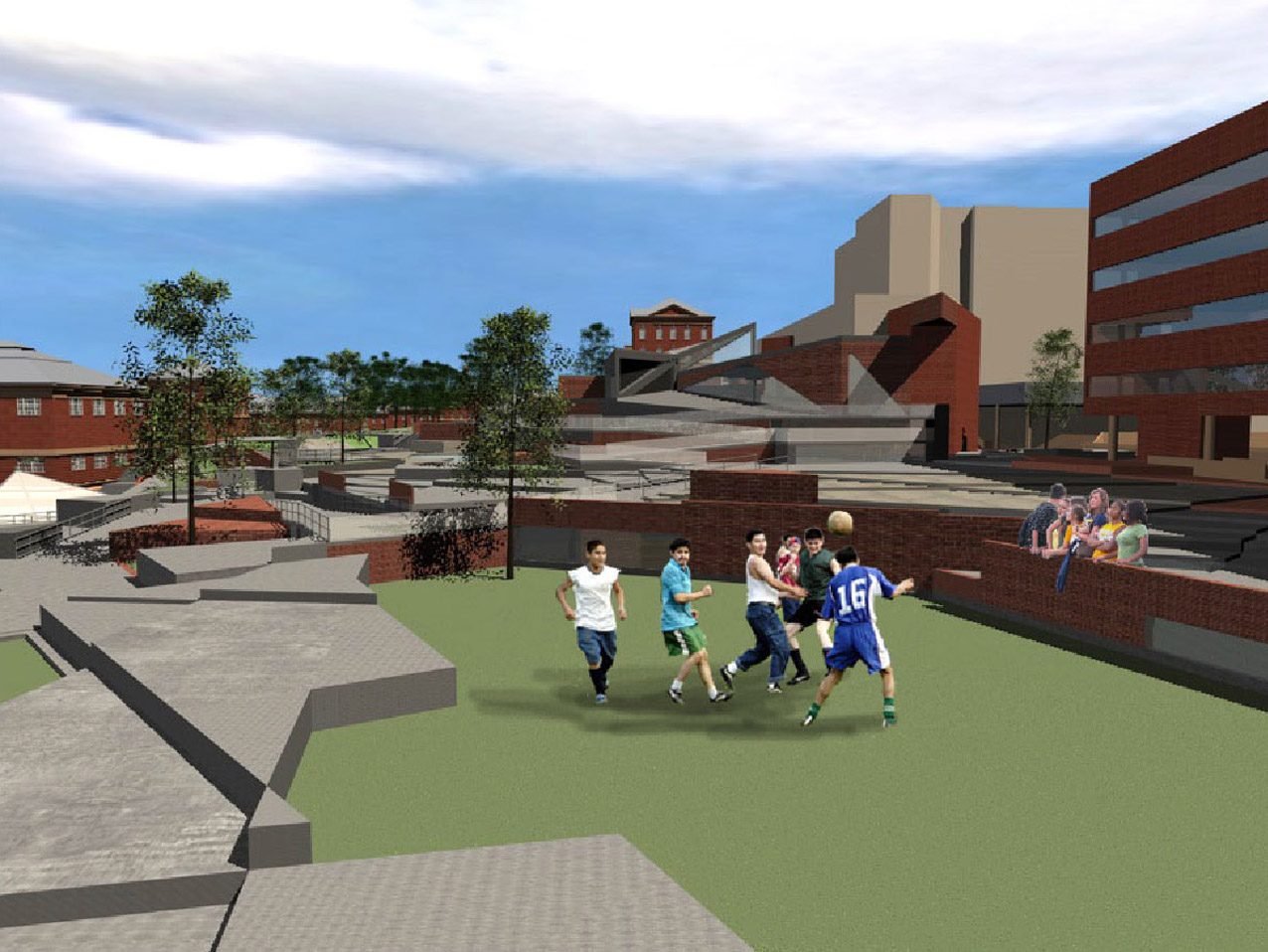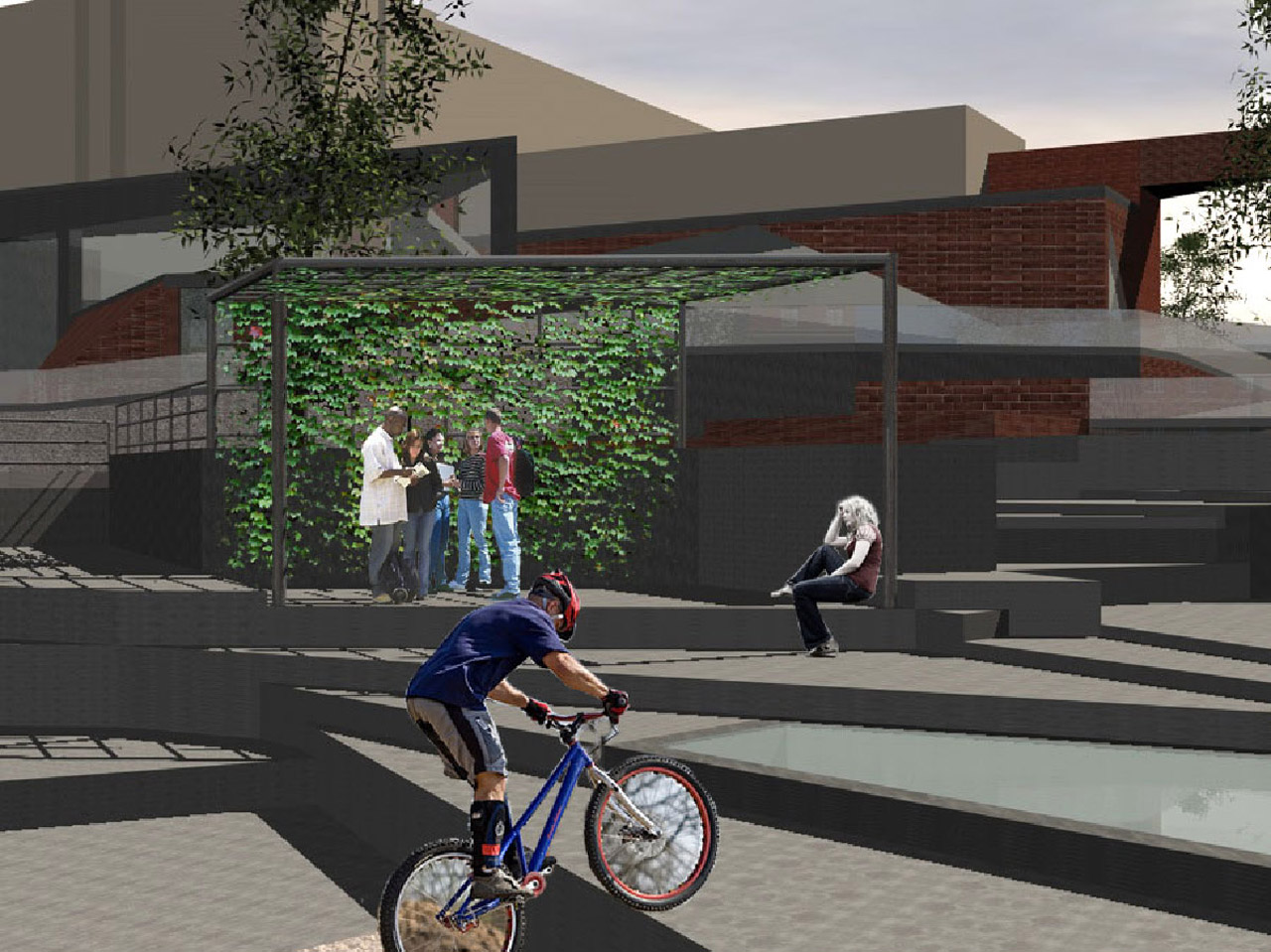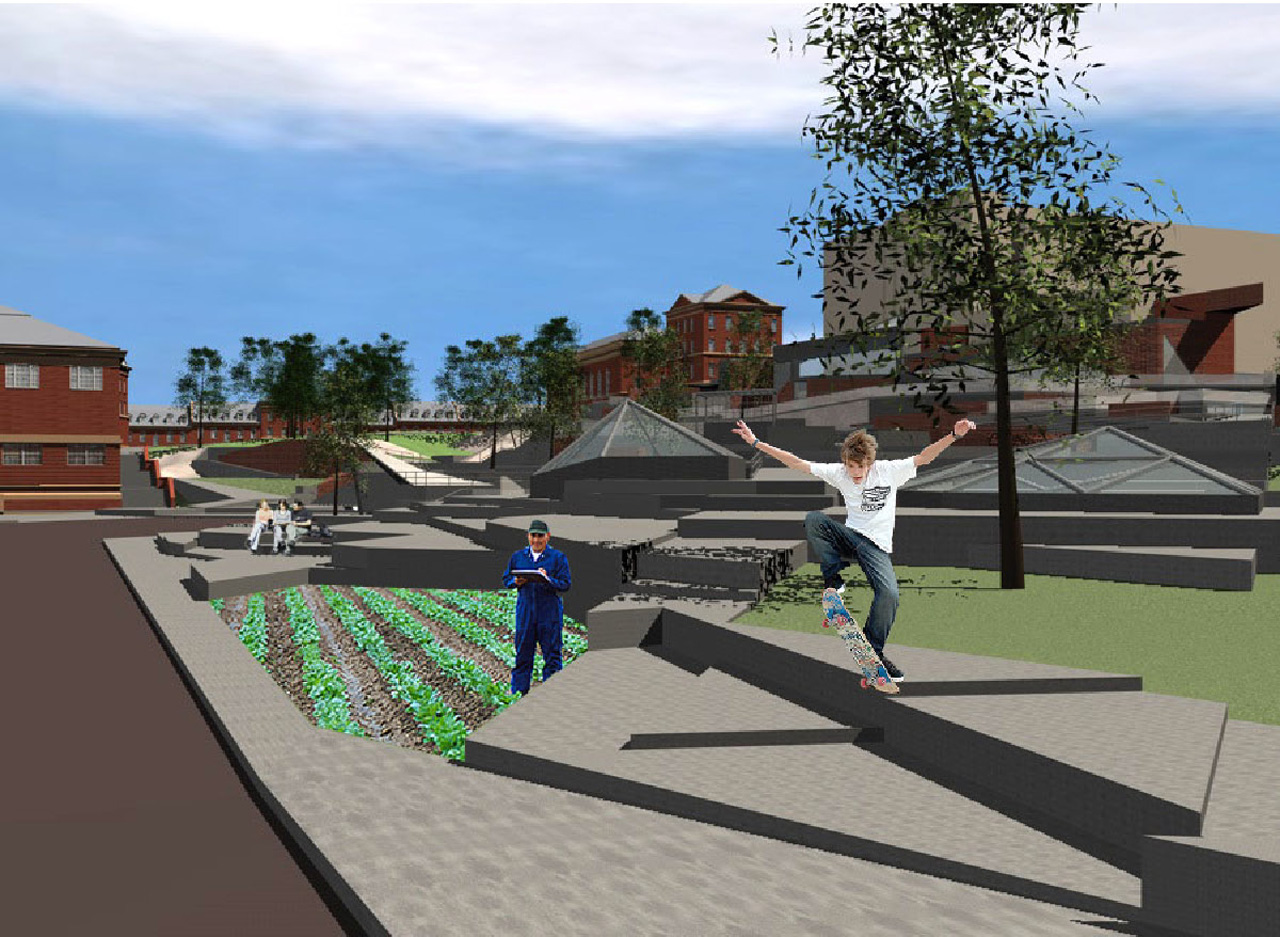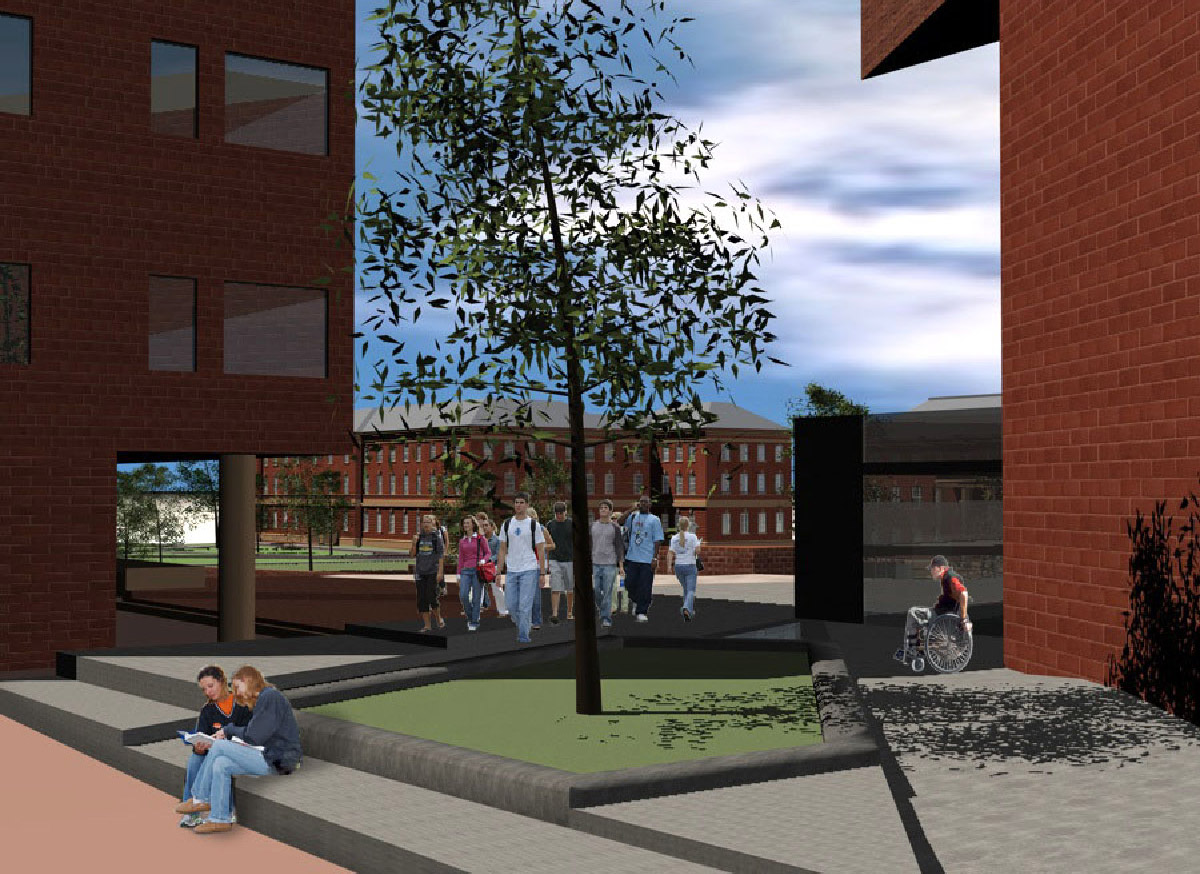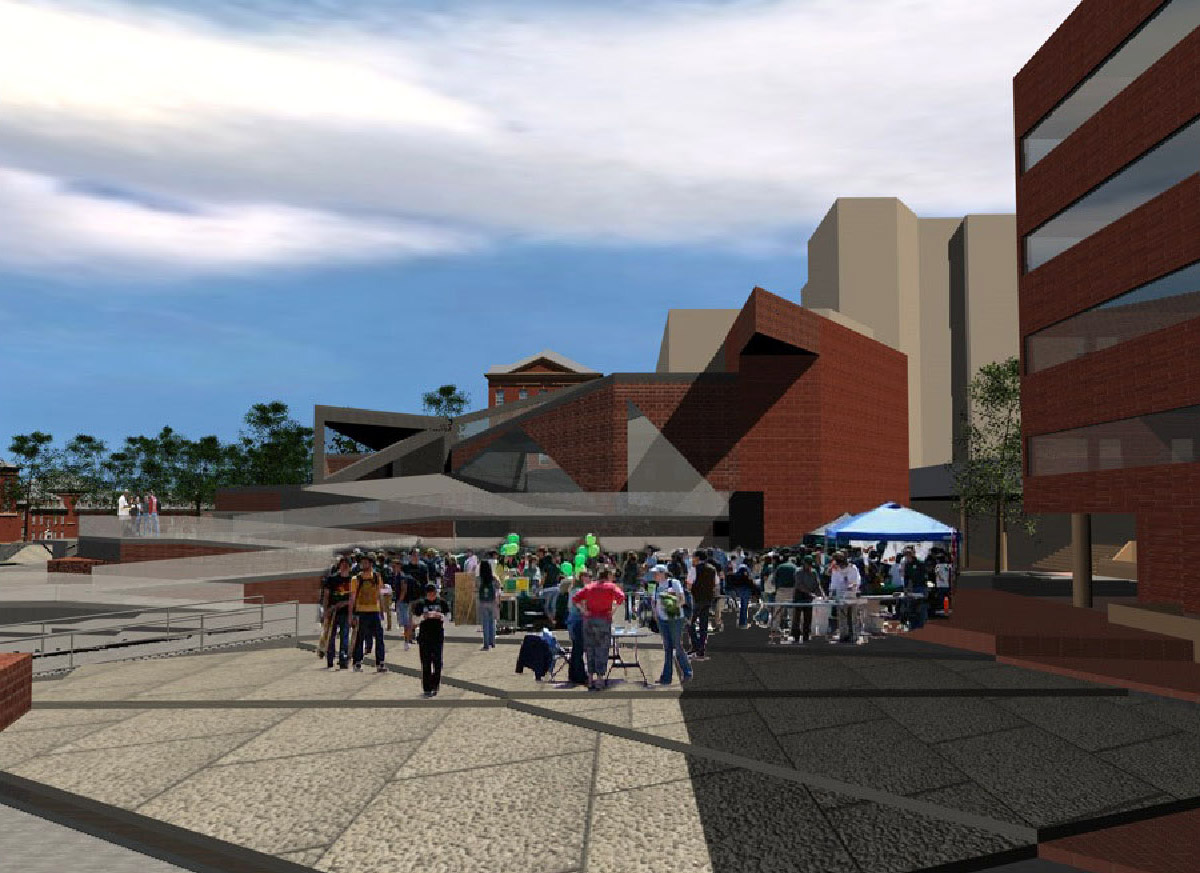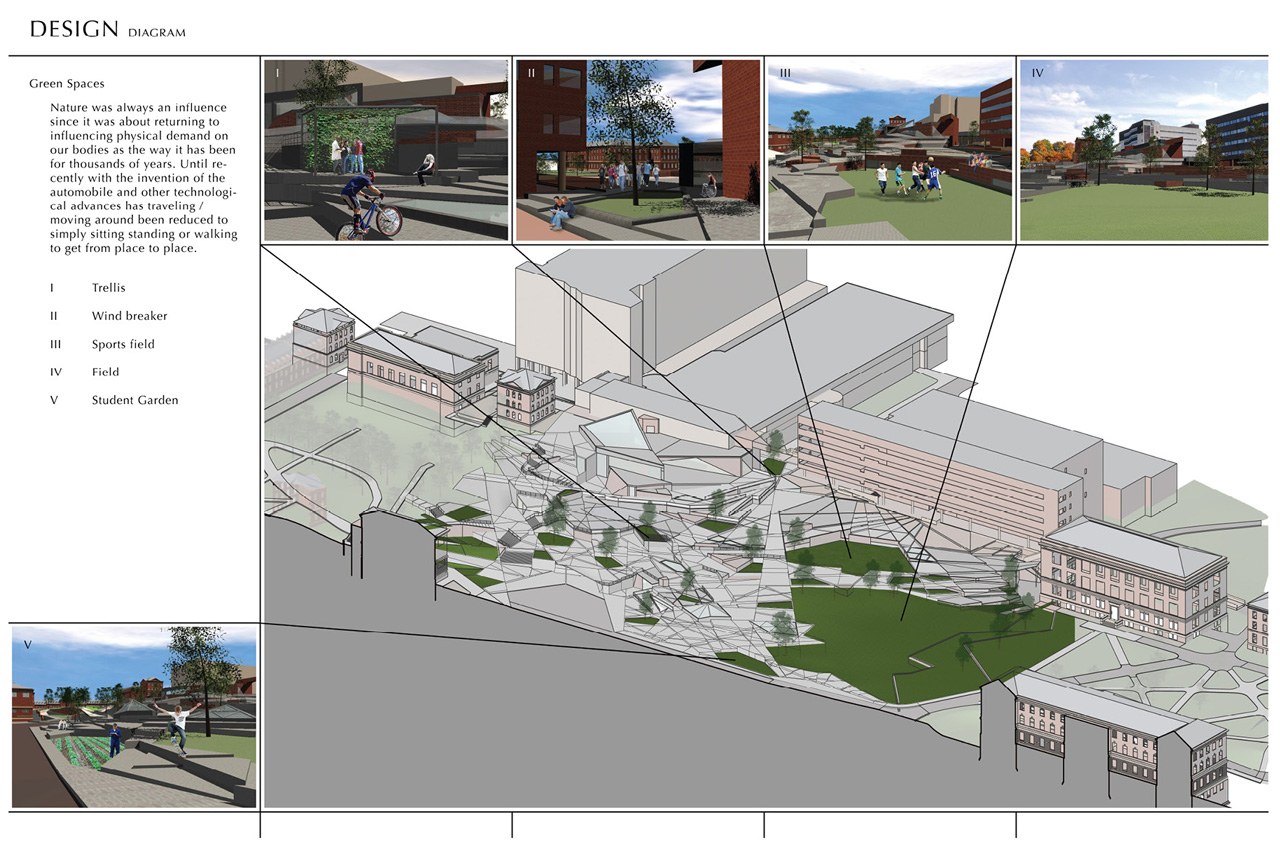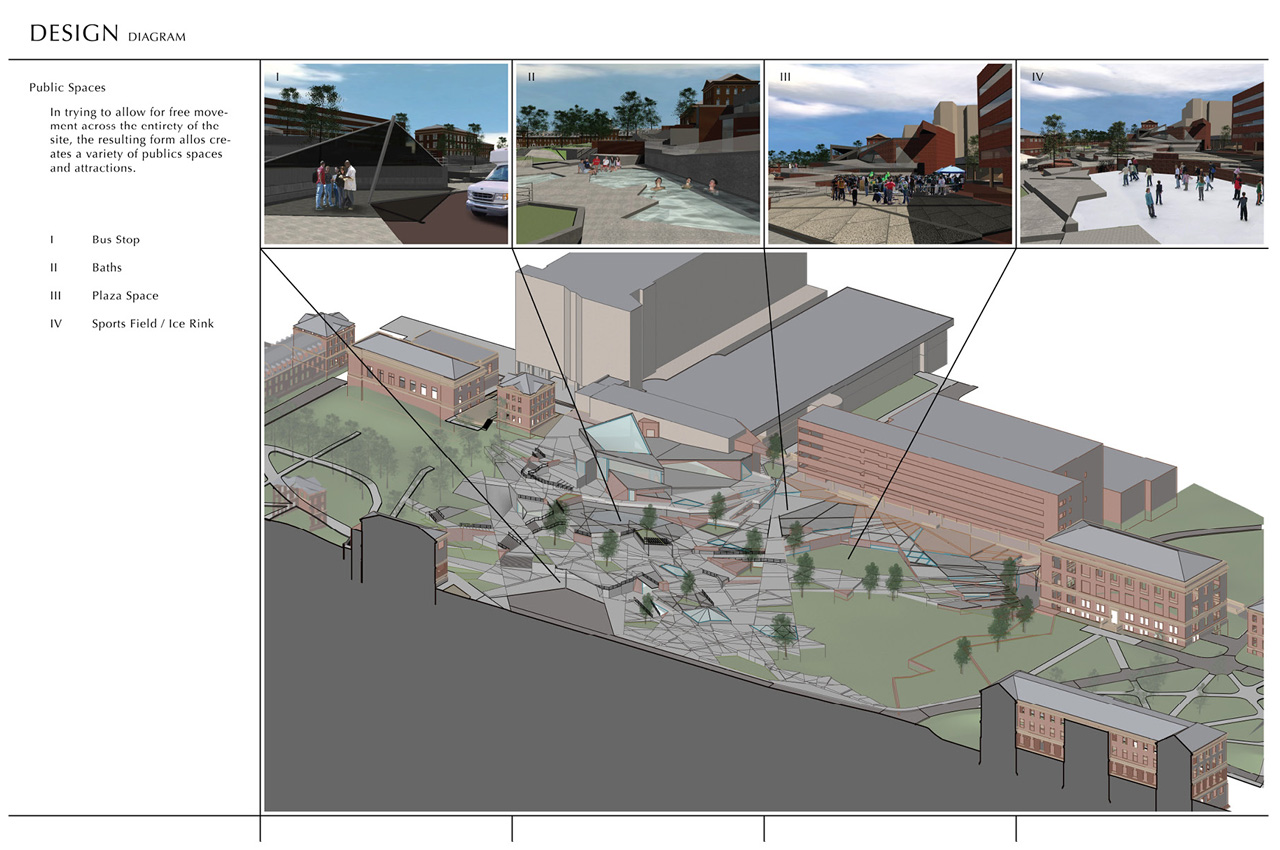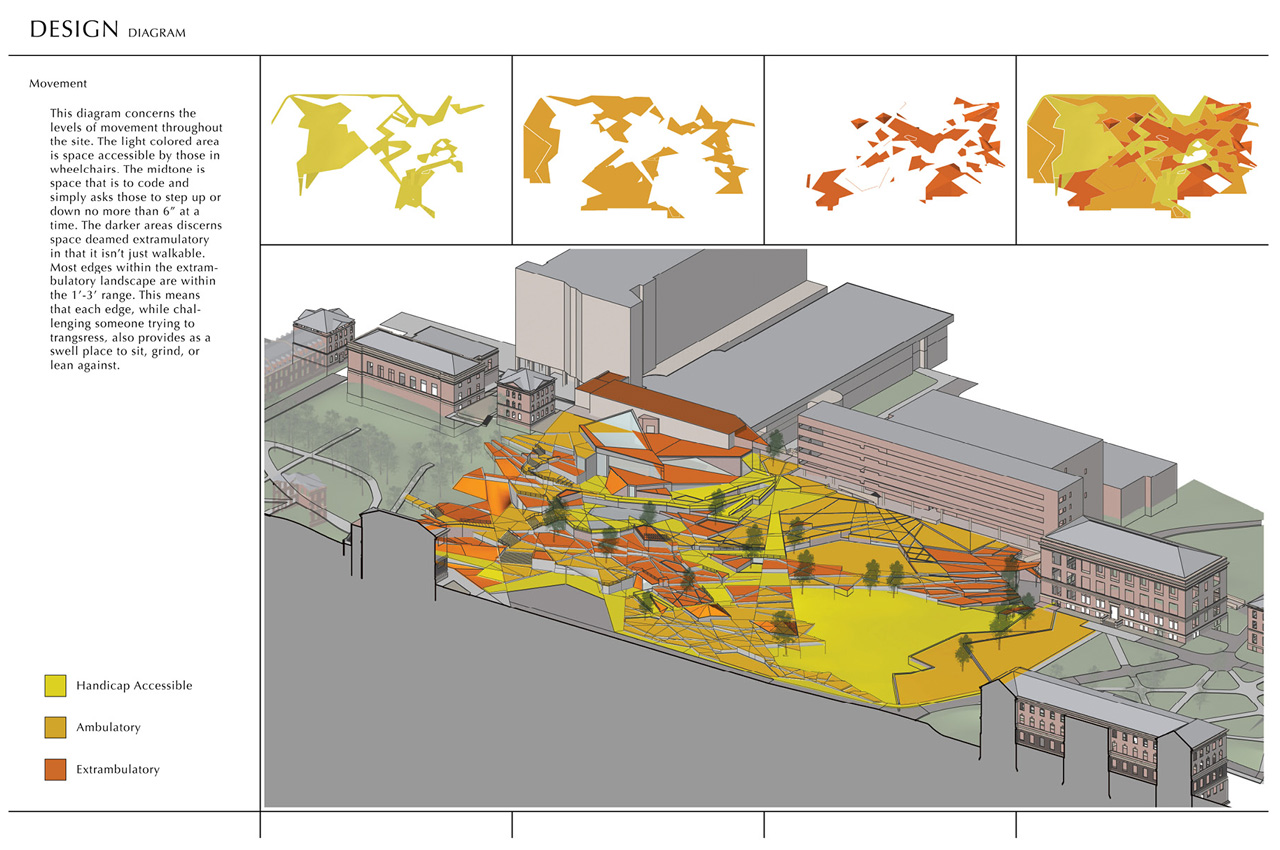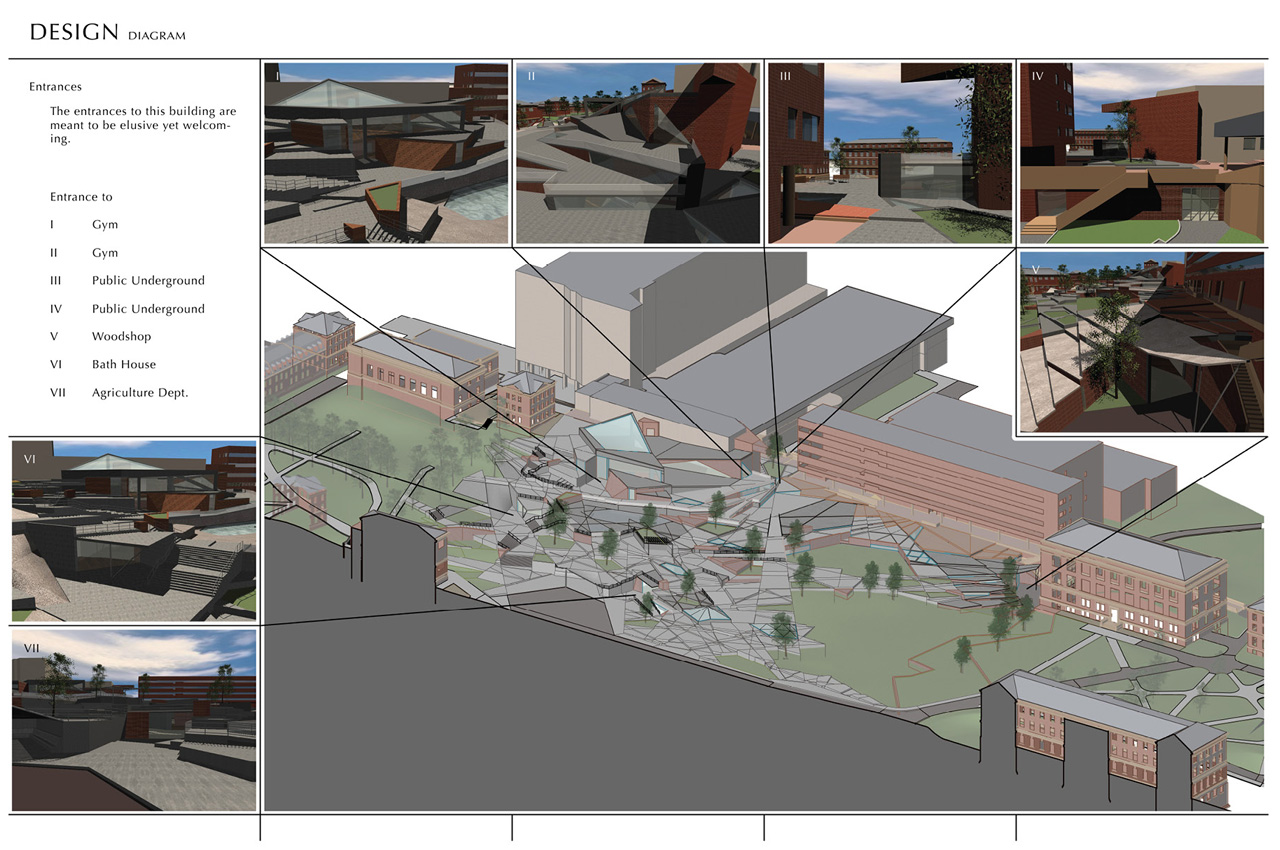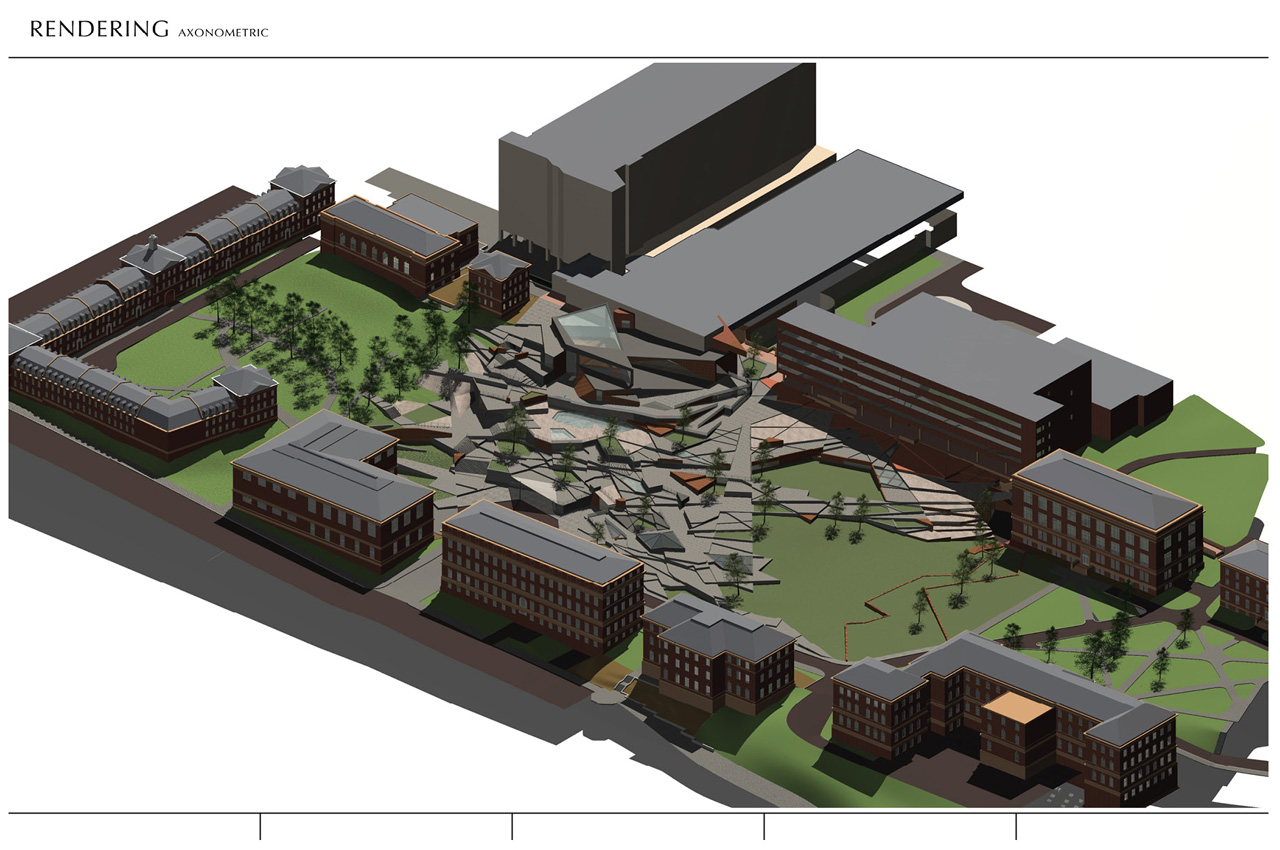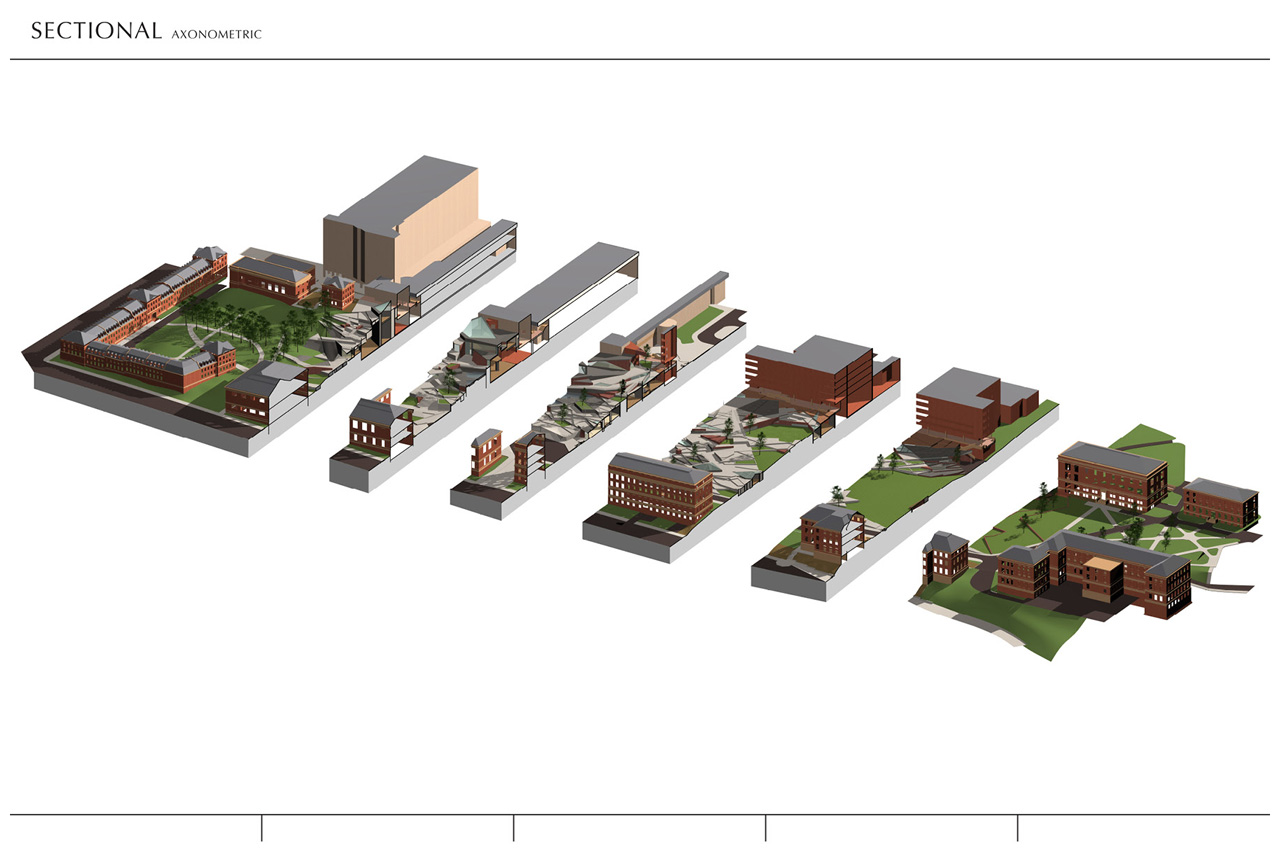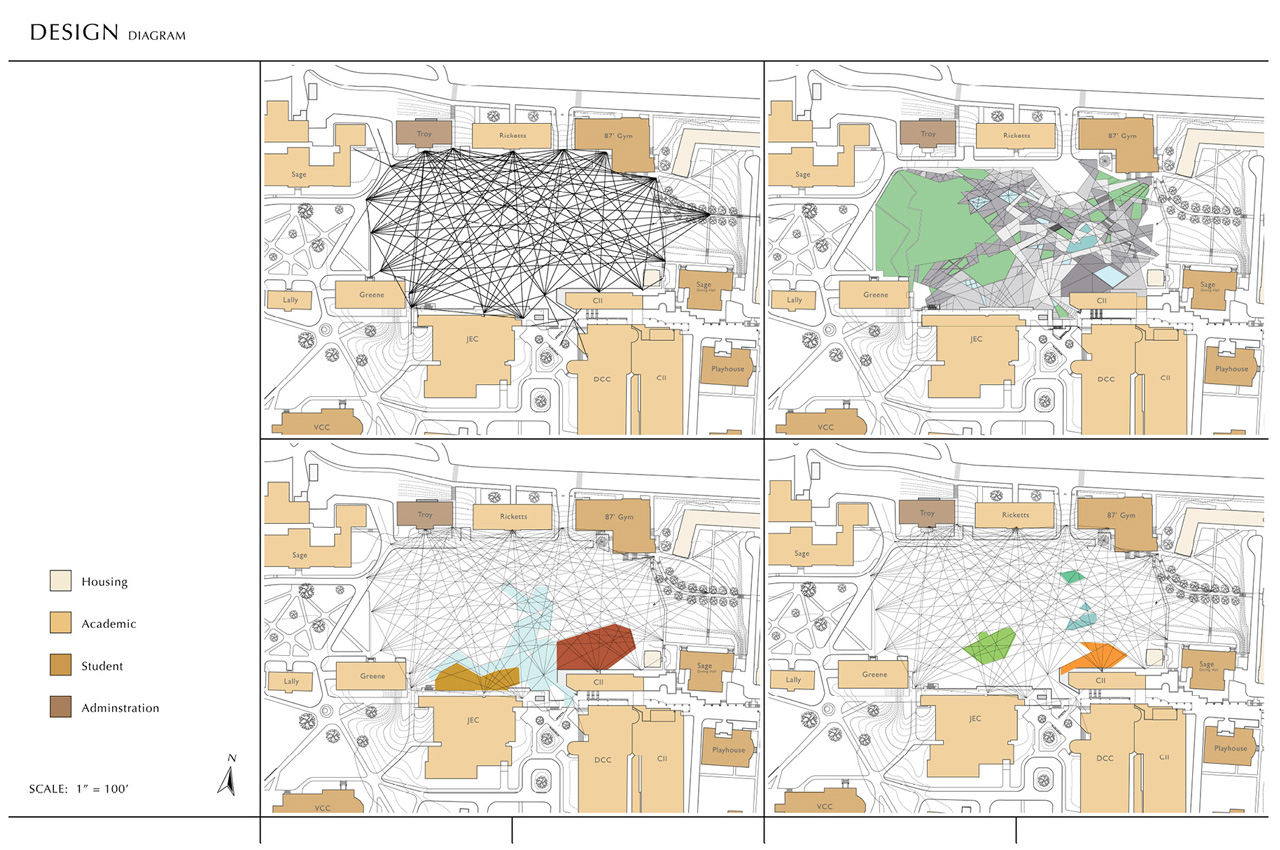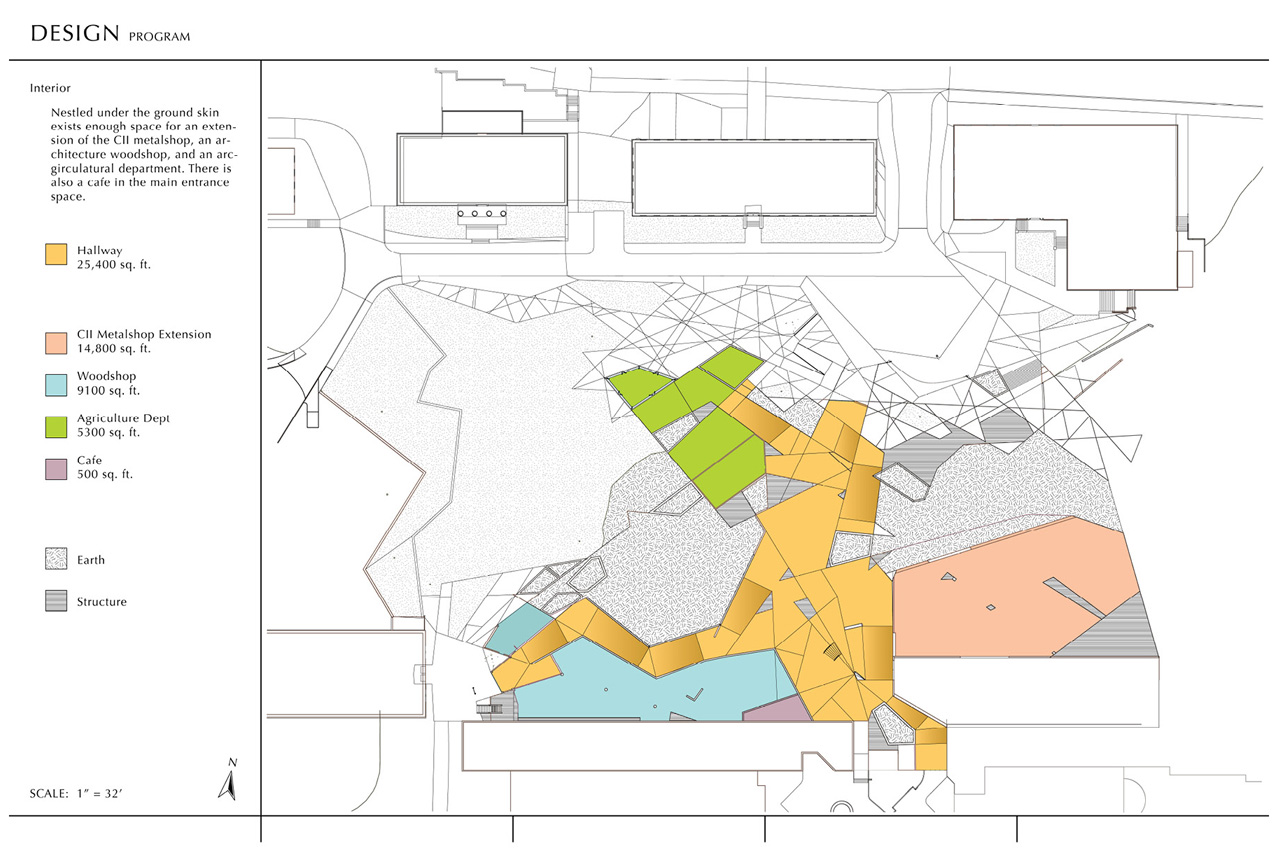Extrambulatory Movement
Thesis Statement
The connection between humans and their architecture is strong, and subtly influential. We walk down straight and flat corridors because the architecture guides us this way. Unless you are handicapped, this is normally taken this for granted. We never really consider traveling with many changes in elevation or having to negotiate obstacles. There is a heavy bias towards efficiency, sometimes to our detriment. Urban architecture for the most part does not engage us enough, mentally or physically.
One out of every four Americans is obese12. This ratio has been increasing since 1985. There are many factors that are causing this rise, and architecture is one of them. Urban architecture asks us to sit, stand, or walk to where we are going. If you transgress the norms of standing, sitting or walking (e.g. skateboarding, scaling a building) you probably will be asked to leave. This is partly due to building code ensuring safety, yet there needs to be a balance, and options.
This thesis proposes an architectural space that challenges the preeminence of efficiency, instead promoting fitness, creativity and athleticism. This model of urban architecture aims to create new pluralities in pedestrian movement and suggests a new approach to programmatic expansion upon an urban environment.
The predominant programmatic strategy of any given city is to grow vertically. However, this project proposes a concept called extrambulation or extrambulatory movement, which attempts to influence traditional programmatic vertical forms into laying out a landscape that finds a balance between horizontal and vertical. This allows for more movement, sight and overall connection between the inhabitants and their architectural context.
These ideas of blending naturalism and horizontal layout were inspired by James Corner’s landscape urbanism. This thesis applies the model of landscape urbanism as a tool to help promote the idea of extrambulatory movement.
Project Statement
The idea of using landscape urbanism to sculpt a form that is rich with multiple decisions for ambulatory and extrambulatory movement, has lead to some great discoveries and consequences. On a macro scale this project will created a space that unifies the campus and utilizes every inch of public space. This project doubles the pedestrian footprint. This is because the “roof” of this space can be understood as an extrambulatory park. Underneath there will be classrooms, greenhouses, metal and wood shops, and a cafe.
However this space is far more than a park, this is about creating a space that rewards creativity, spontaneity, agility, and encourages a local population to become more fit, physically. Physical fitness leads to mental fitness, thus those who frequent this site often may become more agile, healthier, and stronger. They will be more aware and in tune with their surroundings. This is architecture provides challenging options to choose among a variety of extrambulatory paths.
Extrambulatory influence on the on program leads to more unique spaces and connections between them. For example in the agriculture center underneath, the only natural light entering the space will be from above through a variety of differently shaped glass slits. As the sun moves throughout the day, these openings for light will create visual connections between students in class and those above engaged in extrambulatory movement.
The changes in elevation that make up the “roof” of this urban landscape challenge those that transgress the site into trying to find the route that is best for them. Like a health maze, If someone chose to step down or up no more than 6” there is a way, but it is elusive. There is also a way for those on wheelchairs to navigate the site.
This space will serve as a place for the campus community and public to congregate. There are spaces below for intellectual challenge and growth just as there are spaces for physical challenge and growth above. And there are outdoor heated baths if you don’t want to do either of those.

Introduction
This thesis started as an investigation in urban circulation, movement, and mobility. I have long noticed a conflict between these aspects of society and urban architecture: urban environments tend to be physically repressing to those traveling within them.
The urban environment only asks for us to walk, sit, or stand to travel from place to place. Consequently, we see a rise in obesity rates and the rising necessity of health foods, dieting, and exercise gyms to maintain societal fitness. Architecture cannot solely be blamed for these problems, but I believe architecture can provide a solution.
Within the current repressive environment, there are many examples of people transcending these boundaries, which inspires ideas of the role architecture might play in undoing these problems. Extreme sports provide one such example. These sports, such as skateboarding, trials biking, parkour, and others, have always fascinated me. The aspect of these sports that appealed to me most was their physical relationships with their undefined urban play spaces, unlike other sports which are confined to a plain physical arena. Unfortunately, skate parks have long been
designated as the only socially appropriate places to pursue these sports, instead of incorporating their richness into the architecture and circulation of a society. This has not always been the case, as some societies, such as that of Ancient Greece, have attempted to avoid the physically repressive problems we now face. They built many of their cities on hills, had public baths, and brought about the Olympics.
While there is no clear answer about why architecture has not addressed these issues, it is possible that the issues of liability from injury and restrictive building codes have prevented progress in this area. Whatever the cause, the current dialogue between urban sports and urban environment is decidedly one-sided.
My ideas for this architecture consistently break the “figure-ground” relationship, as put forward by James Corner and Stan Allen. Thus, their ideas of landscape urbanism—the relationship between the natural environment and the built environment—are prevalent in my final project.

Man In Nature
In the next few pages, my idea of a more physically dynamic urban space is illuminated with respect to several ideas: man’s relationship with nature, the idea of the pedestrian versus the urban environment, and the architectural theory derived from these concepts.
There is a strong correlation between the healthiness of a person and the type of environment s/he lives in. There are obviously major differences between the natural environments of humans that existed in several centuries ago from those of today. For early humans, moving within a natural environment helped a person to be fit, agile, and healthy. Today’s environments, in contrast, tend to promote obesity and unhealthiness in the inhabitants. Furthermore, technological changes have meant that more and more urbanites spend much of their time physically frozen, staring at a computer screen.
Nature provides challenges to the body. In nature, the ground is rarely level in any instance. One must use many different parts of one’s body to safely navigate the terrain. Hiking provides one good example of this; hiking
is generally recognized to have great physical benefits in addition to its aesthetic ones. My thesis poses the question: what would it be like to hike to work? The idea of extrambulatory movement attempts to introduce the physicality of nature into the urban environment.
George Hébert, a French physical educator who studied many different Neolithic societies, was fascinated by their physical development from work and nature. He writes, “their bodies were splendid, flexible, nimble, skilful, enduring, resistant, and yet they had no other tutor in Gymnastics but their lives in Nature.”1 Influenced by Jean-Jacques Rosseau, Hébert believed that nature was the key to one’s physical development, and was very devoted to his “Natural Method”.
“The final goal of physical education is to make strong beings. In the purely physical sense, the Natural Method promotes the qualities of organic resistance, muscularity, and speed, towards being able to walk, run, jump, move quadrapedally, to climb, to walk in balance, to throw, lift, defend yourself and to swim.”1

Pedestrians vs the Urban Environment
Hébert’s work has spawned an underground movement known as Le Parkour (also known as free-running). David Belle is also credited with helping to found the movement. Parkour groups can be found in many of the world’s largest cities. This l’art du déplacement is the physical sport of breaking out of the constraints of governed circulation. This paper will revisit the subject of parkour and other extreme sports later.
With respect to modern urban environments and their everyday inhabitants, our present urban circulation simply requires people to walk, stand, or sit to get where they are going. One reason for this is that building codes, in an effort to keep everyone as safe as possible, reduce the amount of effort, attention, finesse, and skill that at one time was a daily requirement to travel from one place to another.
The institutions that currently govern the regulation of urban circulation attempt to make that movement as efficient as possible. These institutions include the rules, laws, and codes regulating pedestrian movement.
The tools these institutions use are railing, ramps, rails, and other such structures. As members of these societies, we understand railings and ledges as barriers across which we must not trespass. Steps are designed with consistent dimensions to ensure safety. Entire cities are built around these devices, with no consideration into the possibilities of higher extrambulatory movement.
For example, what would be the effect of a hemisphere 50’ in diameter with a center raised 2’ placed in the middle of a path? It seems that some people would choose to walk around the edge, while other would choose to take the extrambulatory path directly across that circle.
The point to this example is that people all have the potential to extrambulate, but the urban environment presents nearly no opportunities to do such a thing. If a space was designed to encourage extrambulation, I believe that we would begin to see new pluralities in all types of movements.

Extreme Sports versus the Urban Environment
There are a number of examples that demonstrate a desire for different modes of circulation. Extreme sports provide one such example. The name “extreme sports” is something of a misnomer, considering that many enthusiasts are not interested in competition or winning. Beginning with Generation X, people began viewing railings as not only an instrument to hold onto for balance, but also a method for moving vertically on a bicycle, skateboard, or rollerblades.
Extreme sports have a collective relationship: the use of creativity in one’s movements across a surface or form, dynamic or static, architecture or nature or any combination thereof. The urban extreme sports are of particular interest to this project since their playing surface is urban architecture, whereas the arenas for other extreme sports are natural. To wit, mountain biking, surfing, snowboarding, and similar sports are performed within natural environments and thus have less influence on urban architecture.
Thus, I would like to once again examine Le Parkour, which has a been a source of inspiration in my exploration of architecture’s applications in providing a more intelligent approach to urban environmental design. Parkour is not exactly an extreme sport, but rather an art or discipline, having more in common with the martial arts. Founded by the Frenchman David Belle, who described it so: “the physical aspect of parkour is getting over all the obstacles in your path as you would in an emergency. You want to move in such a way, with any movement, as to help you gain the most ground on someone or something, whether escaping from it or chasing towards it.”6 When presented with a hostile confrontation, one has the option to speak, fight, or flee. As martial art is a form of training for the “fight” , parkour is a form of training for the “flee”.
The objective of parkour is to find the most direct way to get from point A to point B. This practice uses the urban environment to develop one’s physical abilities. Railings, walls, and other vertical elements are designed to force movement along or down steps, ramps, sidewalks and other forms of path. Parkour teaches its practitioners not to be confined by what many perceive as boundaries, and to learn to navigate the environment in directions not intended by its designers.

Architectural Theory
To this point, this paper has developed the idea that there are more creative and healthier forms of movement than the walking, sitting, and standing to which we are accustomed. It has also been posited that our society’s acceptance of these standard movements is due to the architecture of urban environments. Furthermore, I have argued for a millennia the human body evolved to navigate a dynamic environment, and withdrawing the aspects of this environment has an effect on our fitness. As a result, our society is plagued by a rising incidence of health problems, such as obesity, caused by a more sedentary lifestyle.
My ideas of landscape urbanism is informed by the work of Stan Allen and James Corner. Their method of landscape urbanism involves the design and organization of space with a mind to natural elements. In other words: the built environment should be informed by the natural environment. Allen points out that landscape is a medium and can provide a model for process. With a mind to this philosophy, my thesis intends to use landscape to create a more physically interactive urban environment.
In The Practice of Everyday Life, de Certeau talks about the art of “making do”. We all have different styles of walking, reading, writing, speaking, and just about all of our other normal activities. These different actions can be viewed a strategies or tactics. A strategy is “the power to provide oneself with one’s place.” A tactic is the “utilization of time, of the opportunities it presents and also of the play that it introduces into the foundations of power”. The standard, un-dynamic urban environment reduces the uniqueness of our movements, reducing the variety of strategies of travel.
However, in urban sports like parkour, trials biking, BMX biking, inline skating, and skateboarding, the obstacles to movement are transformed into attractive challenges. The relationship between sport and architecture is obvious here. This demonstrates a transcendence of societal constructs, rules, and public utilization of space. These obstacles are thus not part of the larger problem, since safety and time are important and worth

while issues in most people’s lives. Rather, it is the lack of any alternative means to travel that forces pedestrians to travel along rigid trajectories through the urban environment. A person has little opportunity to investigate, explore, and experience the architecture around them. Within a natural setting, a person may follow paths and trails, but still has the potential to leave these spaces and improvise his/her own route. This thesis imagines an urban environment that serves the desire to get to a destination in the fastest and safest way possible, but also offers the opportunity to challenge oneself and improve one’s fitness.
While a sculpture may attempt to reflect these feelings, but my intention here is to physically embody them, to provide a direct challenge for those experiencing a space, and to make people rethink traveling between points by the same route every time.
Extrambulatory movement in architecture is intended to enhance the physical fitness of those experiencing it. Landscapes promoting extrambulation are designed to reward intuition, creativity, strength, agility, and spontaneity. It will hopefully engender a healthier population, and one with an enhanced ability to act proactively in times of need or emergency.
Architecture has the ability to more a person both physically and metaphorically. Buildings can convey emotions, ideas, and values.
“We want [buildings] to shelter us. And we want them to speak to us.”
Ruskin4
Our present urban environment has lost this ability when it comes to pedestrian circulation. Physically, the architecture would serve the population better if it could speak to its population’s potential, and encourage one’s exploration.
While there are many examples of physically challenging architecture, there are none that have been designed specifically with the intent to challenge people in a variety of levels and ways. The idea of extrambulation is intended to expand the role of architecture in society.
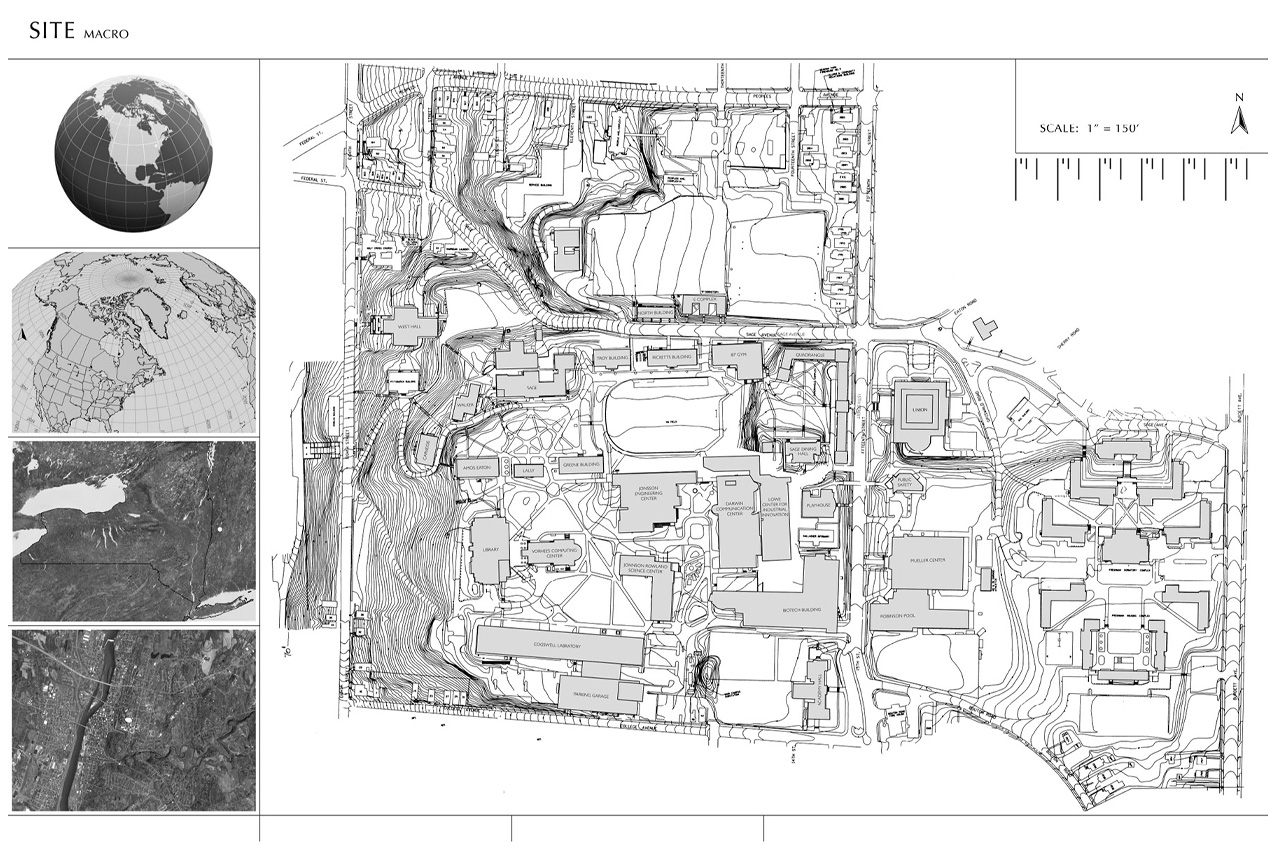
The Site
This site was chosen for it’s dominating and crowded campus paths. Looking at the center of campus there is an old football field, known as the 87’ field. Rensselaer’s rising football team and student size have outgrown this field and consequently are building a new athletic stadium by the Houston fieldhouse. For years this fenced in field has gouged two main pedestrian thoroughfares through campus [left diagram].
Rensselaer Polytechnic Institute also provides an excellent population to work with as well, being that most of the student body lives on or near campus and commutes mostly by foot.
There is also almost 50’ of elevation change across the site. This is important since I want to work not only with the context but the given nature as well.
So...
Dense pedestrian traffic + Growing student body + Change in elevation + Context + Wind + Sun + Extrambulatory Movement = ?
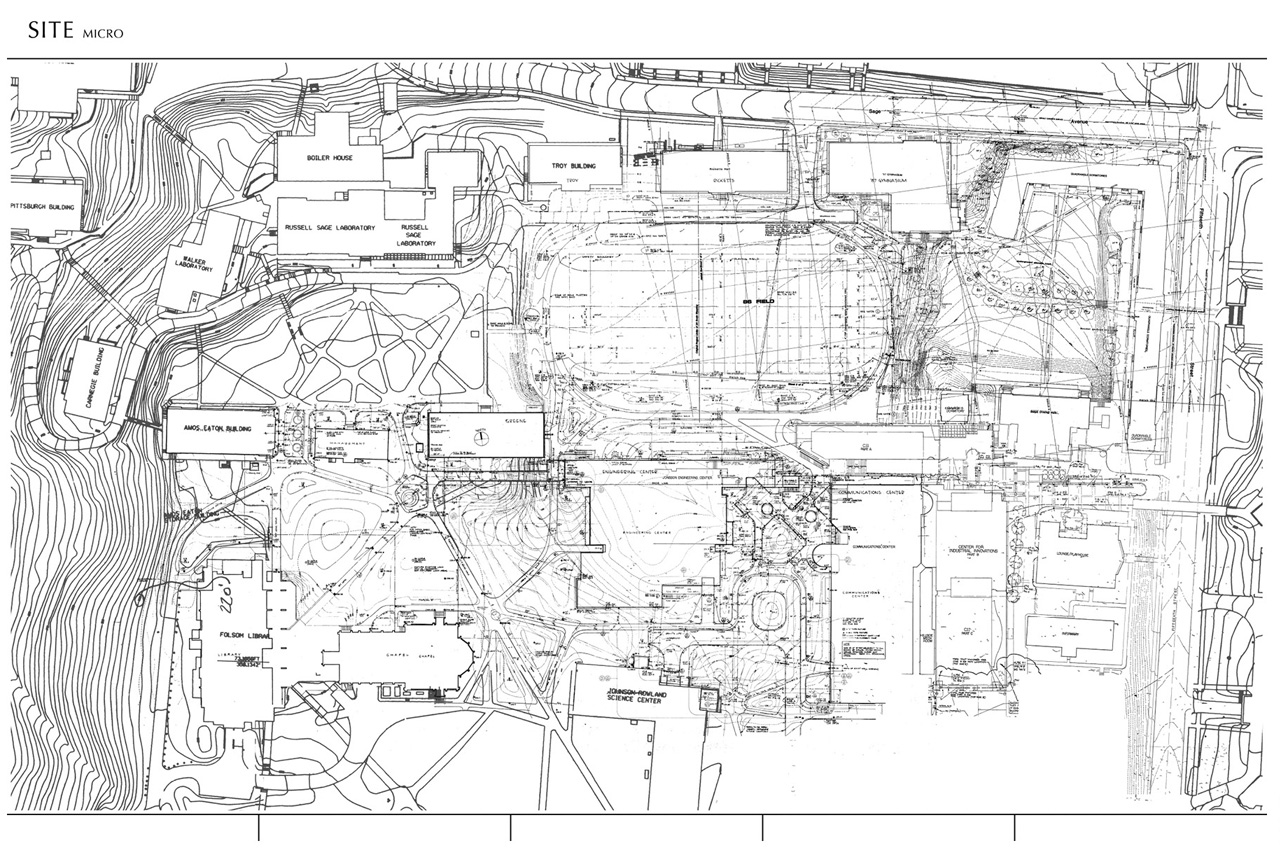
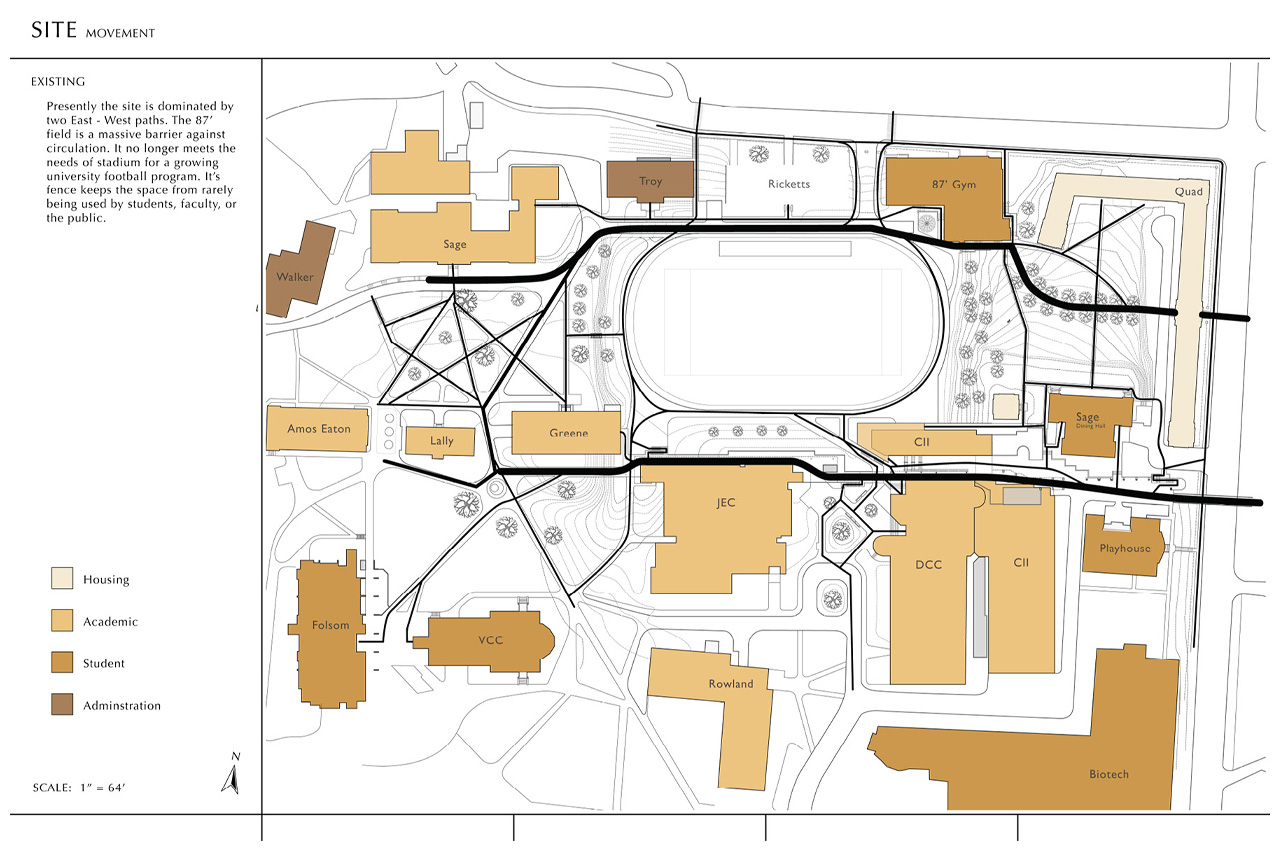
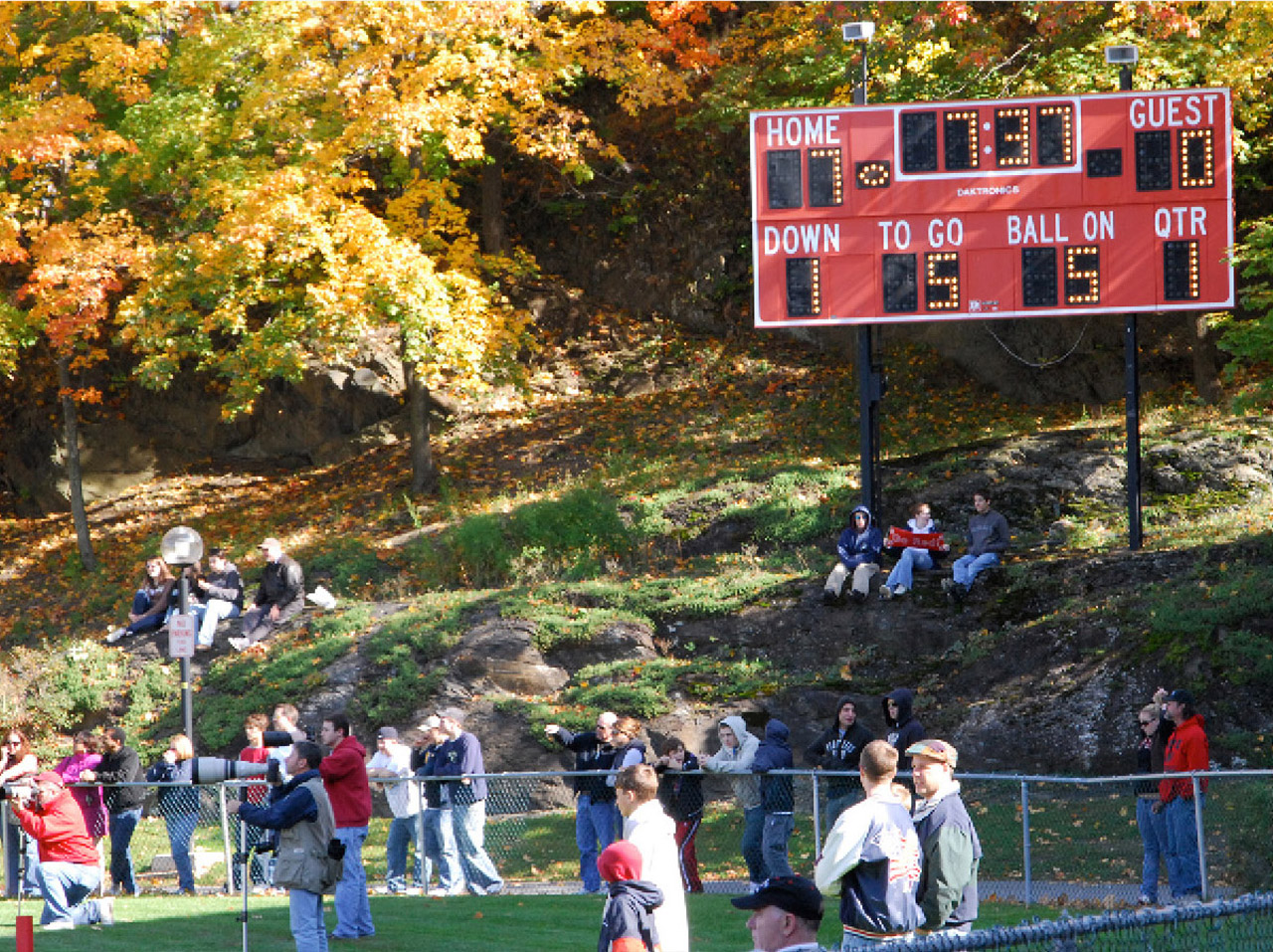
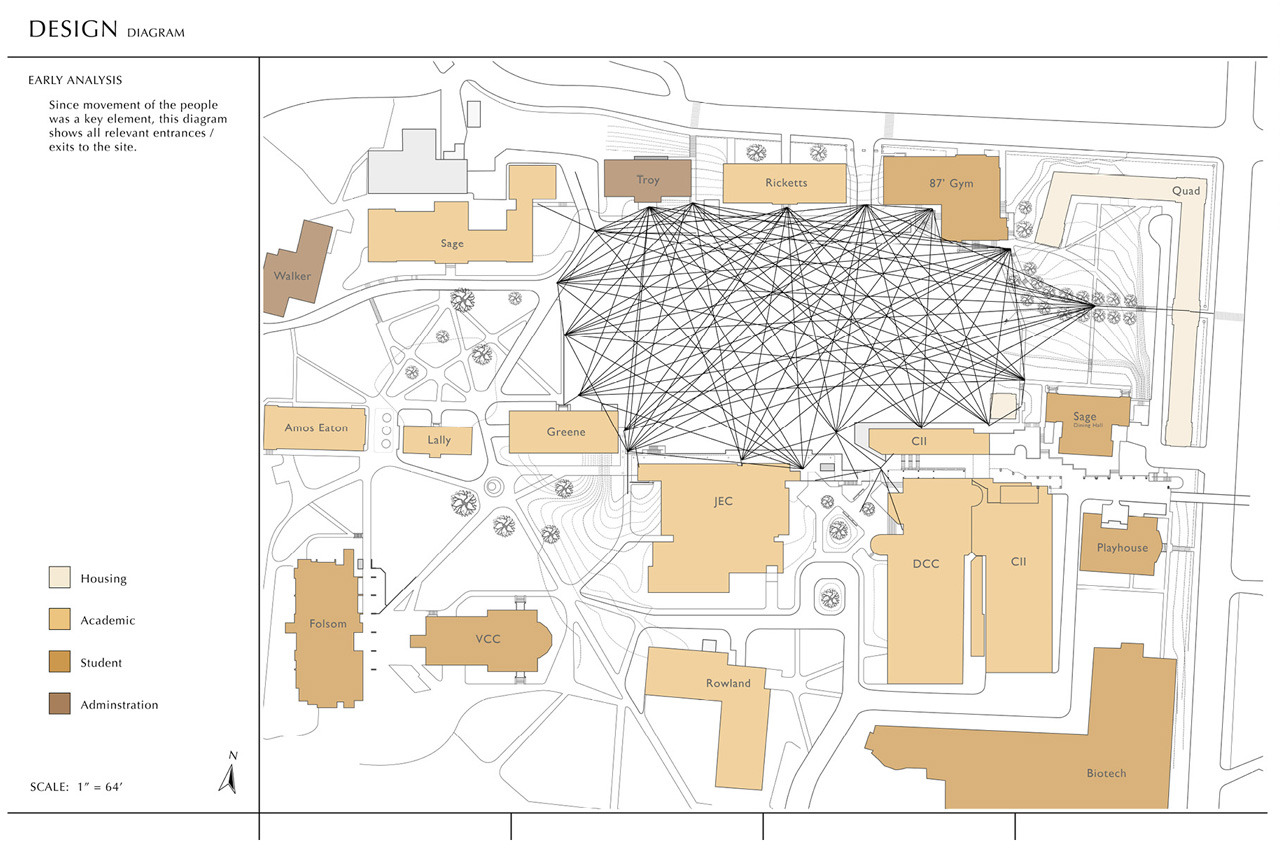
Design Method
On my seventh attempt I came up with this form for the site. In this iteration, I started by identifying all of the entrances to the site. Entrances consisted of points that people would orient themselves to as a destination, such as a door to a building or a set of stairs, upon entering or exiting the site.
This gave me the diagram that you see to your left. I then used the site lines to split a large surface into about a thousand irregular shaped surfaces. I then began to move each one up and down until there was some degree of clarity about its purpose.
Within this system I found I could group surfaces together to create grander surfaces. I also had to decide upon a material for each surface. I had a list of programs on paper and in my head that help me create and connect each space. This logic is diagramed on page 21 and onward.
There is also a loophole in the code that I exploited, in that being no edge or ledge need not a railing if the drop-off is less than 32”. So I tried to make as many of the edges no more than this height to allow for more freedom in one’s movement.
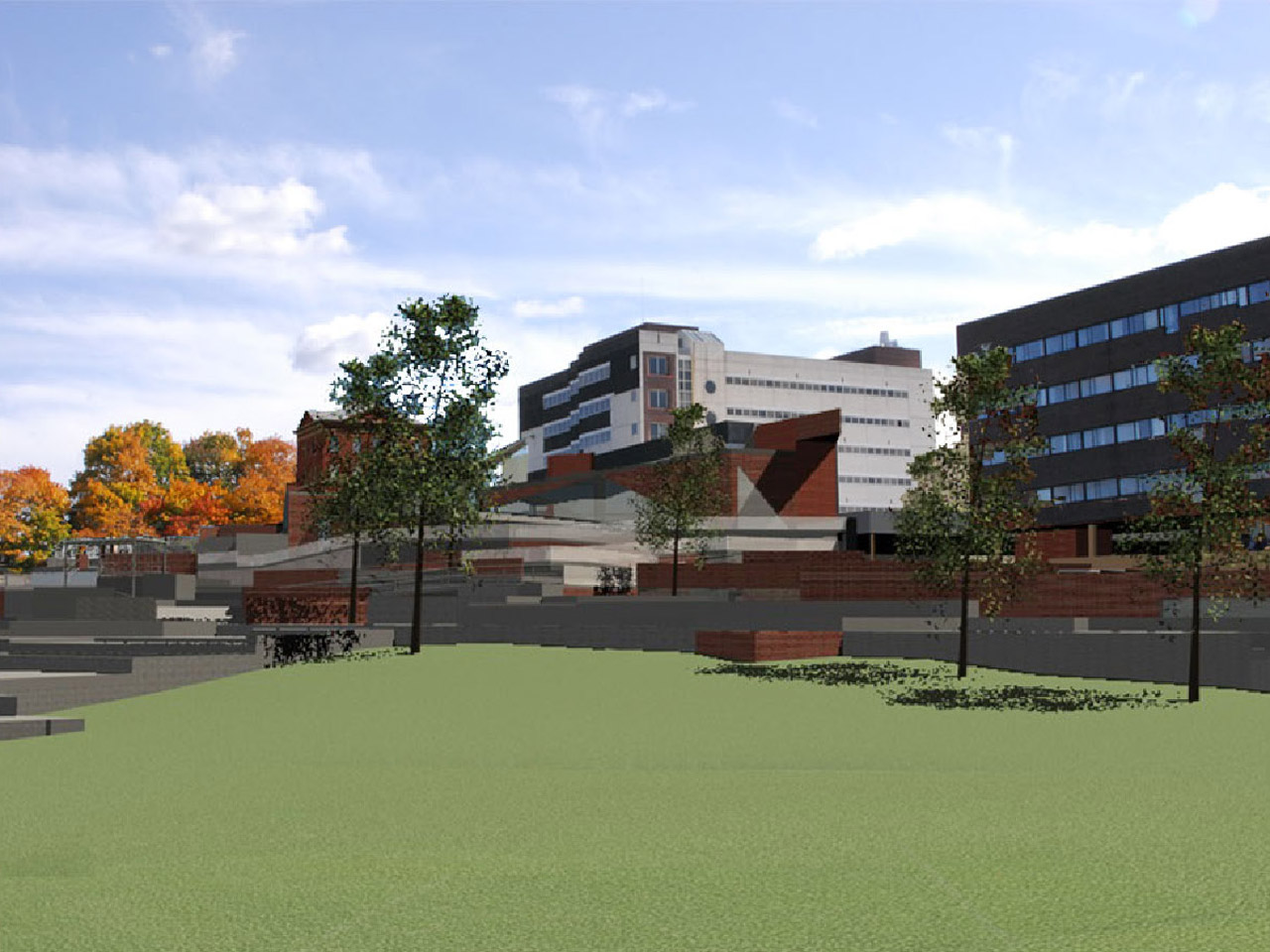
Architectural Consequences
This is about encouraging the transgression of the “path”. Upon transgressing this site a person will be the chooser of his path, and no longer simply marching along.
Consequently, while allowing free movement on a variety of levels, the form also provides for a variety of public spaces. There are large open areas for speeches, concerts, or other large gatherings. And then there are smaller and more intimate spaces often nestled under a tree or a trellis for random meetings or classes outside. Since many of the edges presented on the site are above normal stepping height yet rarely over hip height, each can serve adequately as a place to sit or grind.
Creating this richness of “the roof” of a building has been a driving factor because the roof of any given building usually presents itself as the hardest place to [climb] get to. The roof is also some of the most valuable space a building can have. So here is where we see the necessity to break the figure-ground relationship, and rethink how to suit the programmatic needs of a growing university campus.
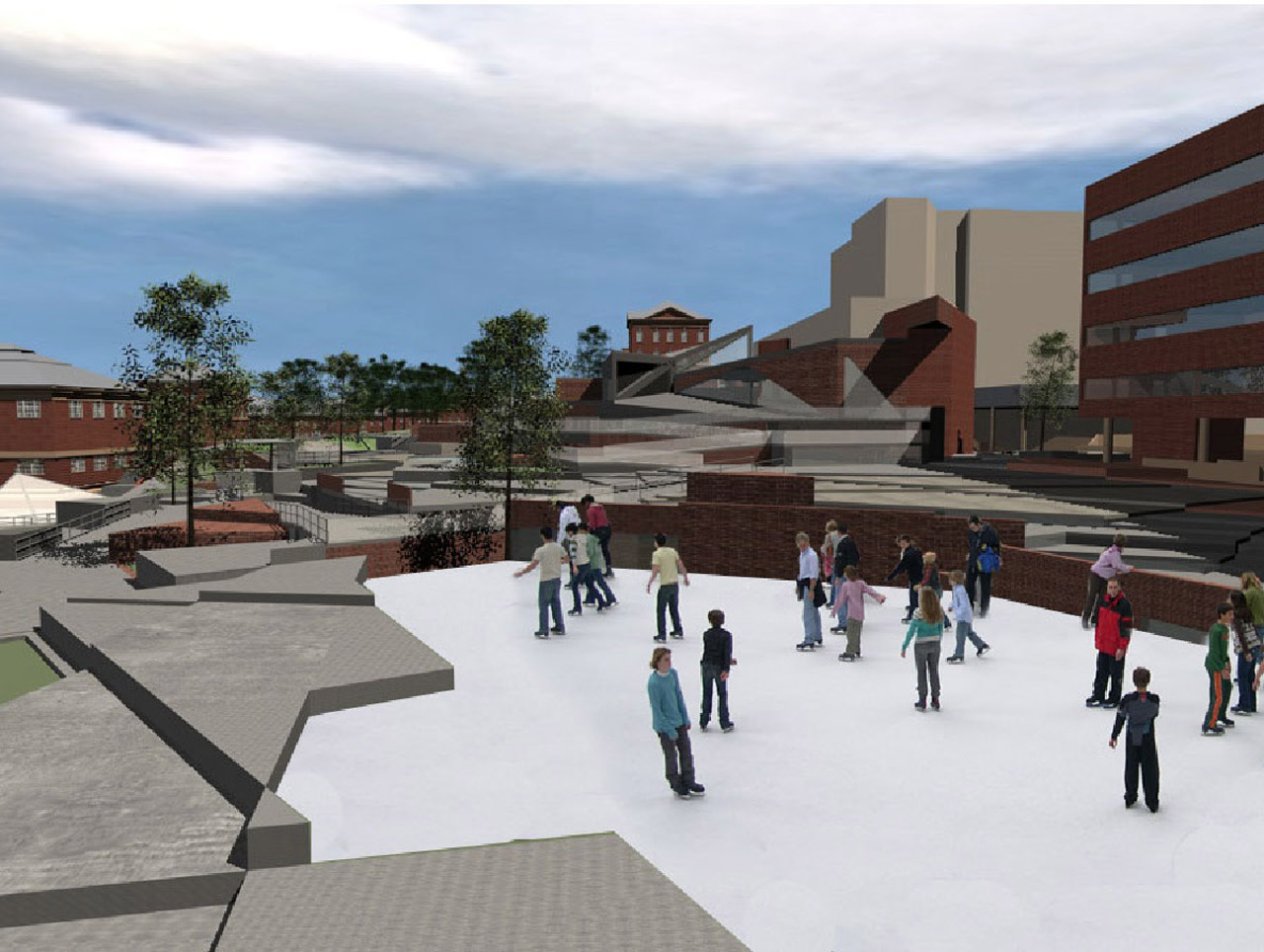
Going back to the roots, desires, and inspirations of this thesis, lets not forget Le Parkour. This site I believe provides an excellent training ground for those enthusiasts. I’m also positive that this site will attract many skateboarders, bikers, skiers and snowboarders as well. Quite possibly putting RPI’s campus on the underground map of many extreme sports.
This space hardly allows for one to walk in a haze. One will have to be aware and adaptive as one transverses the space. Until after a while their subconscious can catch up and adapt and then they will be able to go back to walking around in a haze, even while extrambling.
One of the reasons breaking the figure ground relationship has been so prevalant, is to leave little part of this architecture inhumanly reachable. To break the plane and establish a building as a figure, it must present a near vertical face of inhuman height, thus creating a overpowerful barrier. The roof is often this forbidden place, wasting some of the most valueable space created by a building. This style is prevalant on many campuses, a trend of classical architecture
